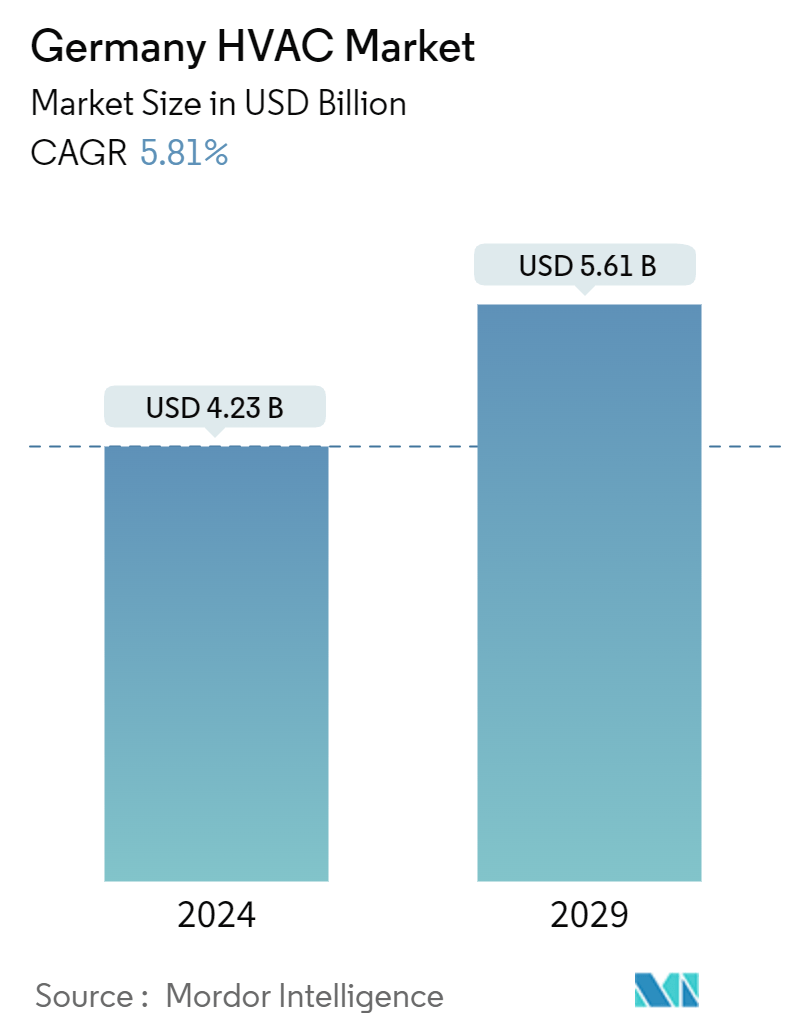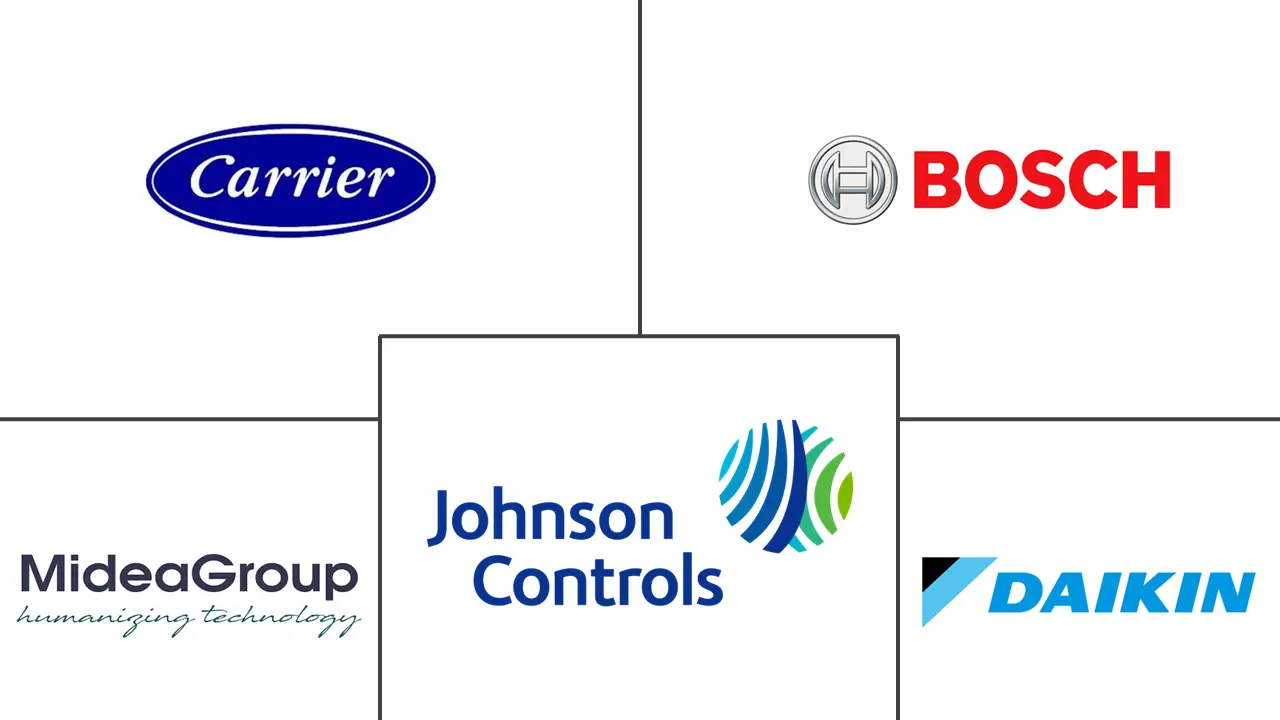Market Size of Germany HVAC Industry

| Study Period | 2019 - 2029 |
| Base Year For Estimation | 2023 |
| Market Size (2024) | USD 4.23 Billion |
| Market Size (2029) | USD 5.61 Billion |
| CAGR (2024 - 2029) | 5.81 % |
| Market Concentration | Low |
Major Players
*Disclaimer: Major Players sorted in no particular order |
Germany HVAC Market Analysis
The Germany HVAC Market size is estimated at USD 4.23 billion in 2024, and is expected to reach USD 5.61 billion by 2029, growing at a CAGR of 5.81% during the forecast period (2024-2029).
- The factors contributing to the expansion of the market in Germany being analyzed include the adoption of advanced monitoring systems, smart technologies, and building automation systems, a greater emphasis on cost savings and maintenance, and improved maintenance and personalized services for HVAC systems.
- Already acknowledged as a mature market for energy efficiency and a green economy, Germany is doubling its efforts in energy diversification and introducing regulations and technologies to tackle climate challenges in HVAC and other sectors. For instance, the government has announced that it would cover up to 70% of the costs of new and sustainable heating systems from 2024, which may let people wait with the applications. Thus, increasing government focus on installing energy-efficient HVAC solutions further drives the role of the HVAC market in the country.
- In addition, the subsidy for heat pumps provided by BAFA in Germany is administered by the Federal Office for Economic Affairs and Export Control. It covers up to 50% of the total installation cost, with a maximum of EUR 3,000 for single-family residences and EUR 6,000 for multi-family homes.
- Integrating new HVAC technologies with existing building infrastructure can be complex and expensive. Issues may exist, especially in older buildings, which can deter upgrades. In addition, although rising energy costs drive demand for energy-efficient systems, fluctuating energy prices can also create uncertainty, impacting investment decisions. Dependence on traditional energy sources can slow the transition to more sustainable HVAC solutions, thus hindering the market's growth.
- Macroeconomic factors like government initiatives and subsidies promoting the adoption of energy-efficient HVAC systems play a significant role. Policies like the energy saving ordinance (EnEV) and incentives for green buildings drive the demand for modern, energy-efficient HVAC systems. In addition, programs offering financial incentives for retrofitting old systems with new, efficient ones boost market growth.
Germany HVAC Industry Segmentation
HVAC systems, short for heating, ventilation, and air conditioning, are designed to regulate temperature and humidity, ensuring comfortable environmental conditions and delivering clean air in buildings. They comprise various components, including boilers, furnaces, refrigerators, humidifiers, and heat pumps.
The study tracks the revenue accrued through the sale of HVAC products in residential, commercial, industrial sector by various players in Germany. The study also tracks the key market parameters, underlying growth influencers, and major vendors operating in the industry, which supports the market estimations and growth rates over the forecast period. The study further analyses the overall impact of COVID-19 aftereffects and other macroeconomic factors on the market. The report's scope encompasses market sizing and forecasts for the various market segments.
The German HVAC market is segmented by type of component (HVAC equipment [heating equipment and air conditioning/ventilation equipment] and HVAC services), and end-user industry (residential, commercial, and industrial). The market sizes and forecasts are provided in value (USD) for all the above segments.
| By Type of Component | ||||
| ||||
| HVAC Services |
| By End-user Industry | |
| Residential | |
| Commercial | |
| Industrial |
Germany HVAC Market Size Summary
The Germany HVAC market is poised for significant growth, driven by the increasing adoption of advanced technologies such as smart systems and building automation. The market is characterized by a strong emphasis on energy efficiency and sustainability, aligning with Germany's commitment to a green economy. Government initiatives, including substantial subsidies for energy-efficient heating systems and incentives for retrofitting older buildings, are pivotal in promoting the adoption of modern HVAC solutions. The integration of heat pumps and other renewable energy sources is becoming more prevalent, supported by regulations encouraging nearly zero-energy buildings. Despite challenges like the complexity of upgrading older infrastructures and fluctuating energy prices, the market is expected to expand as energy costs rise and demand for efficient systems increases.
The competitive landscape of the German HVAC market is fragmented, with major players like Carrier Corporation, Robert Bosch GmbH, and Daikin Industries Ltd. actively engaging in strategic partnerships, innovations, and acquisitions to enhance their market presence. Recent developments include Apleona's acquisition of Air for All, which strengthens its technical systems portfolio, and Vargas Investment Group's launch of Aira, a subscription-based heat pump service. These moves reflect a broader trend towards innovative business models and technological advancements. The market's growth is further supported by government grants and policies aimed at increasing the use of renewable energy sources, ensuring a robust demand for HVAC services in the coming years.
Germany HVAC Market Size - Table of Contents
-
1. MARKET INSIGHTS
-
1.1 Market Overview
-
1.2 Industry Attractiveness - Porter's Five Forces Analysis
-
1.2.1 Bargaining Power of Suppliers
-
1.2.2 Bargaining Power of Consumers
-
1.2.3 Threat of New Entrants
-
1.2.4 Threat of Substitute Products
-
1.2.5 Intensity of Competitive Rivalry
-
-
1.3 Industry Value Chain Analysis
-
1.4 Impact of COVID-19 Aftereffects and Other Macroeconomic Factors on the Market
-
-
2. MARKET SEGMENTATION
-
2.1 By Type of Component
-
2.1.1 HVAC Equipment
-
2.1.1.1 Heating Equipment
-
2.1.1.2 Air Conditioning /Ventilation Equipment
-
-
2.1.2 HVAC Services
-
-
2.2 By End-user Industry
-
2.2.1 Residential
-
2.2.2 Commercial
-
2.2.3 Industrial
-
-
Germany HVAC Market Size FAQs
How big is the Germany HVAC Market?
The Germany HVAC Market size is expected to reach USD 4.23 billion in 2024 and grow at a CAGR of 5.81% to reach USD 5.61 billion by 2029.
What is the current Germany HVAC Market size?
In 2024, the Germany HVAC Market size is expected to reach USD 4.23 billion.

